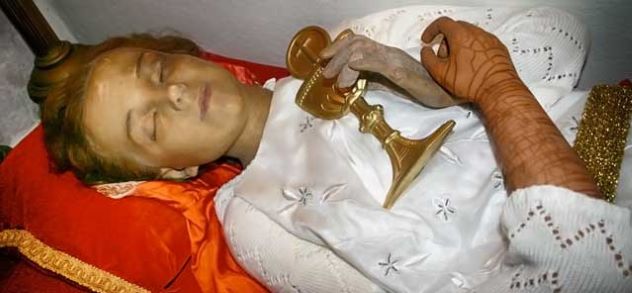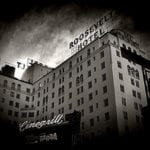 Music
Music  Music
Music  History
History 10 Less Than Jolly Events That Occurred on December 25
 Weird Stuff
Weird Stuff 10 Funny Ways That Researchers Overthink Christmas
 Politics
Politics 10 Political Scandals That Sent Crowds Into the Streets
 Weird Stuff
Weird Stuff Ten Bizarre Facts About The Doge Meme
 Our World
Our World 10 Ways Your Christmas Tree Is More Lit Than You Think
 Movies and TV
Movies and TV The 10 Coolest Stars to Set Sail on The Love Boat
 History
History 10 Things You Didn’t Know About the American National Anthem
 Technology
Technology Top 10 Everyday Tech Buzzwords That Hide a Darker Past
 Humans
Humans 10 Everyday Human Behaviors That Are Actually Survival Instincts
 Music
Music 10 Surprising Origin Stories of Your Favorite Holiday Songs
 History
History 10 Less Than Jolly Events That Occurred on December 25
 Weird Stuff
Weird Stuff 10 Funny Ways That Researchers Overthink Christmas
Who's Behind Listverse?

Jamie Frater
Head Editor
Jamie founded Listverse due to an insatiable desire to share fascinating, obscure, and bizarre facts. He has been a guest speaker on numerous national radio and television stations and is a five time published author.
More About Us Politics
Politics 10 Political Scandals That Sent Crowds Into the Streets
 Weird Stuff
Weird Stuff Ten Bizarre Facts About The Doge Meme
 Our World
Our World 10 Ways Your Christmas Tree Is More Lit Than You Think
 Movies and TV
Movies and TV The 10 Coolest Stars to Set Sail on The Love Boat
 History
History 10 Things You Didn’t Know About the American National Anthem
 Technology
Technology Top 10 Everyday Tech Buzzwords That Hide a Darker Past
 Humans
Humans 10 Everyday Human Behaviors That Are Actually Survival Instincts
10 Creepy Cool American Catacombs & Crypts You Can Visit
There’s something about an underground tunnel that I personally love. It’s dark, spooky, full of spiders and low-hanging pipes—and sometimes, there are dead people. It’s romantic and educational! (I was not the average thrill-seeker as a child, okay?)
When I think of crypts, catacombs, and underground cities, I jump to antiquity first. There are the necropolis under the Vatican Basilica and the burial crypts of ancient Egypt. Don’t forget the famous Catacombs in Paris and Palermo. By definition, a crypt is a “chamber, such as a vault, wholly or partly underground especially: a vault under the main floor of a church.” It makes sense we would associate crypts and underground cities of bones with our European counterparts and ancient ancestors. It’s not something we think could exist under our feet in cities in the U.S. like Boston, New York, or even Seattle.
So here’s a look at some of the American crypts and subterranean cities you can visit (and I recommend it) if you’re into winding tunnels, mystery, history, and sometimes just centuries-old dead guys. No judgment here.
Related: 10 Bone-Chilling Facts About the Catacombs of Paris
10 Seattle, WA
Believe it or not, Seattle, Washington, has an entire secret underground city that burned down in a large fire in 1889. The new city was simply rebuilt on top of the old ruins, which are still open to tours today. Between 1890 and 1907, the old ground floor continued to be used. Merchants either carried on business on the bottom floors that had managed to survive the fire or the new above-ground layer. Pedestrians then used the now-underground levels with sidewalks lit by the pavement lights above.
As you can imagine, the Underground level led to the seedier businesses. In 1907, the city condemned the Underground out of fear of the bubonic plague that was spreading along the West Coast at the time. Underground Seattle became abandoned and left to deteriorate and for use as storage. All the new abandoned space under the city became tempting accommodations for vagrants, illegal gambling, prostitution, opium dens, and speakeasies.
Today, you can visit the Seattle Underground on one of many tours. There are still artifacts and relics down there from decades past. It’s creepy and supposedly haunted, as most underground cities reportedly are.[1]
9 New York, NY
If a more somber tour of a crypt is your thing, I would recommend popping over to New York City. Right off Mulberry Street, you’ll find St. Patrick’s Old Cathedral, with the only active Roman Catholic cemetery in Manhattan outside its doors. Some of the inhabitants are over 200 years old. The cathedral itself was the largest in the United States when it was completed in 1815, and it was the seat of the first Bishop of the Diocese of New York. Much of the wooden cathedral interior burned to the ground in 1866 in a fire set off by a kitchen stove.
Step inside today and walk down into the basement, however, and you can take a “candlelight” (It’s an LED flashlight, you know, because of the fire) tour of the crypt beneath the church. You won’t see any visible bones, but you will see lined hallways with ornate vaults and notable inhabitants. There’s Countess Annie Leary, the Delmonico family, and “Honest John” Kelly, to name a few. Oh, and upstairs, you’ll see where Francis Ford Coppola filmed the baptism scene in The Godfather.[2]
8 Indianapolis, IN
Indiana is not a place where you’d think an underground catacomb tunnel network would exist, but it does. And it so happens that it’s very creepy to behold if you’re by yourself. Trust me on this one.
In 1886, the city of Indianapolis constructed two public buildings on Market Street designed by architect Dietrich Bohlen. These buildings were: City Market and Tomlinson Hall. City Market remains a thriving and beloved part of the downtown community of Indianapolis. Tomlinson Hall, however, disappeared from the cityscape in January 1958 when a fire ravaged the area. The city took down the remains later that year.
Today only its iconic arch and basement, known as the Catacombs, mark this once vibrant space. You can tour the catacombs as well! According to the city, the Catacombs qualify as both a ruin and a redevelopment opportunity, and they welcome visitors to explore the city’s past, present, and future. They have gone on record to say that Indianapolis’s Catacombs don’t contain bones or crypts (that they know of) but rather scores of brick barrel-vaulted arches. Nonetheless, it’s a cool space to visit if you get the chance. If you do find bones, high tail it out of there.[3]
7 Atlanta, GA
Let’s talk about The Crypt of Civilization at Oglethorpe University. You’ve probably never heard about it unless you were really into the Guinness Book of World Records in the early ’90s or lived in Atlanta at some point. So, for background, I grew up in Atlanta and once went on a field trip to Oglethorpe University, where I saw The Crypt of Civilization. As a 10-year-old kid, I was intrigued and invested in opening this crypt and pretty much have been ever since.
There are no bodies (we think) inside this crypt. They also claim there are no valuables, gold, or jewelry inside this crypt. So, what is it? Very few facts exist about The Crypt itself. According to the University, “The Crypt of Civilization at Oglethorpe is the oldest millennial time capsule in conception and the largest in the world. In 1936, detailed plans were executed to build an extraordinary time capsule—one designed to store records for over 6,000 years, done on what could perhaps be described as an epic scale never before conceived. The visionary of this improbable quest was Oglethorpe University president Dr. Thornwell Jacobs, who has been called ‘the father of the modern time capsule.’” Jacobs was convinced that his generation could be the first to perform what he later called “our archaeological duty.” This was an obligation to provide for future historians “a thorough and accurate record, scientifically selected and preserved, of life in the twentieth century.” Some more facts to include:
• The Crypt of Civilization was sealed on May 28, 1940
• It is not to be opened until May 28, 8113
• No, you can not go inside; but you can visit the sealed stainless steel door
A lot has changed in the world since 1940. Oglethorpe has access to a lot of human archaeological archives. What’s in this crypt? Your guess is as good as mine. We’ll have to wait until National Treasure 3 or the end of the world to find this one out. I recommend going to look at the door if you’re in town. It’s as ominous and mysterious as you’d think.[4]
6 Waterbury, CT
This is the only catacomb I’m truly scared of. Holy Land, USA is a religious “theme park” in Waterbury, CT, and nothing really says fun for the family like getting tetanus or succumbing to a deteriorating cave-in.
The park was originally opened in 1955 by John Baptist Greco, a totally normal lawyer, but it closed to the public in 1984 and was subsequently vandalized. It was also the site of the rape and murder of a 16-year-old girl in 2010. It was subsequently purchased by a local non-profit and reopened on September 14, 2014, with an inaugural Mass and access to ruins of the grounds. So, what’s the story about the catacombs here?
At the height of the park’s popularity, there was once an attraction called “Catacombs: A History of the Church.” But it now serves as a stark warning of the deterioration of the space. According to a local review: “Any foray into these ancient burial chambers would likely end with a slip down a hidden staircase with your forehead impaled on a plank of rusty nails.” Nope.
Originally, it ran about 200 feet along the old parking lot in a series of corridors. Viewed from the parking lot, it appears to be underground but is actually all above the surface. On the far end, a small entrance contains a sign: “The Pictorial Life of Christ—From the Cradle to the Cross.” Another crudely hand-lettered sign lists every pope up to 1978. The area is open to the public during daylight hours. I would not recommend tempting your fate and going after hours. There are plans to reopen the park in its former glory. [5]
5 Cincinnati, OH
Cincinnati has a lot of old European architecture engrained into the heart of the city, from the restaurants to apartments and even down to where it buries its dead. It’s not often that a group of families comes together to request their long-dead relatives remain buried together. But that’s exactly what happened at Over-the-Rhine’s St. Francis Seraph Church. The original church was called Christ Church and was built in April of 1819 by the first Catholics of Cincinnati. In March 1822, Edward Fenwick, first bishop of Cincinnati, took possession of Christ Church as his cathedral. Later that year, the new bishop had Christ Church moved to a location downtown.
The cemetery remained while the city grew up around it. In November 1858, the cornerstone was laid for the present St. Francis Seraph Church. The remaining bodies were entombed in a crypt, Poets’ Corner–style , below the altar of the new church, which was consecrated on December 18, 1859.
There they stayed for more than 100 years, inaccessible to everyone except the inhabitants of the friary, which remained cloistered until the 1970s. Now, thanks to the American Legacy Queen City Underground Tour, you can see the crypt in person.[6]
4 Newark, NJ

In 1937, Father Mateo Amoros was working as the assistant pastor at St. Joseph’s Church in Newark, New Jersey. Father Amoros reportedly took a trip to Montreal that same year, saw some catacombs, and decided that his church should also have them. The problem? The state of New Jersey generally frowned upon opening a new burial chamber beneath the church and told him no. However, Father Amoros had a much grander (and, honestly, creepier) vision in mind for his catacomb.
Instead of human remains, he would have wax corpses of saints and martyrs. By doing this, he opened America’s first wax museum, and you can still visit this “crypt” today. You can see some of the greatest hits, including St. Tarsicio, a 12-year-old altar boy who was beaten to death for refusing to surrender his Eucharist. Also, St. Genaro, who was “thrown into a lighted oven” and “thrown in with wild beasts” for choosing Christianity over paganism. Nearby lies St. Ines, “obedient girl and role model,” who refused to marry a Roman—she said she was already married to God. She then escaped vengeful murder because she was a virgin. So she was dragged to a brothel, deflowered, and then vengefully murdered.[7]
By the way, this catacomb was also listed on a site as a top place to visit for Catholic field trips. Lovely!
3 Columbia, SC
You can’t buy a ticket to tour the Columbia catacombs, but if you’re brave enough, you can see the mysterious tunnels that all the residents know about. However, no one has an explanation for why they really exist.
“Elaborate brick arches. A two-century-old phenomenon. Cypress floors. Confederate gold. Beautifully crafted brickwork. Underground architectural wonder. Clandestine passageways for state officials. Part of the Underground Railroad.” These phrases include some of what Columbia residents use to describe and explain the tunnels. Built in the 1800s, their original purpose remains a mystery.
Chris Robinson, a professor at USC, has visited and written about the catacombs extensively. He’s even taken artifacts in hopes of finding answers as to why they’re there. So far, no bodies have been found, but the tunnels are miles long—as long as they are ornate. If you’re the adventuring type, go see for yourself and try to answer the centuries-old mystery.[8]
2 Washington, DC
D.C. has a little bit of everything. You can drop by the White House and try to catch a glimpse of the sitting President, grab some food over at Ben’s Chili Bowl, and even visit the truly breathtaking catacombs and gardens at the Franciscan Monastery. Wait, what?
Built in the late 1800s and early 1900s, the Franciscan Monastery served as a place for Americans to go when travel to the Holy Land was difficult. Exploring the catacombs makes visiting the monastery feel like a unique adventure, unlike a typical trip to a museum. The designers of the monastery even traveled to the Holy Land and consulted travelers to capture every detail. They wanted a visit to the Franciscan Monastery to feel as authentic as possible. And since the 1920s, the catacombs have been home to the bones of a young child, Saint Innocent, the martyr, that came from the Catacomb of St. Callistus.[9]
1 Boston, MA
If you’ve been to Boston, you’ve probably stopped by the Old North Church. At the very least, you’ve heard the story of Paul Revere making his famous ride. It’s a rite of passage living in America, I think. What you probably didn’t know is that the Old North Church has a very elaborate crypt underneath it, and there’s plenty of space if you still want to be buried there today. It’s a lot cheaper than you’d think, and you don’t even need to kick out the dusty neighbors. (However, you would have to be cremated!)
Old North Church houses in its basement a crypt containing approximately 1,100 burials. From 1732 to 1860, the church interred congregants below its very floorboards. Since the church has plenty of space beneath and little space above ground, they decided to make the most of what they had to meet the burial demands of the congregation. In the basement, 37 separate brick vaults comprise the tombs in each of which 20 to 40 full coffins could be deposited.
The crypt tour is dark, dusty, and full of history, as you’d probably expect. If you’re tall, you’ll have to watch out for those low-hanging pipes. You’ll be able to see an open vault with an 18th-century coffin still intact. There might even be a ghost or two lingering around, but what else do you expect for the city where it started?[10]






![10 Creepy Images From American Courtrooms [Disturbing] 10 Creepy Images From American Courtrooms [Disturbing]](https://listverse.com/wp-content/uploads/2020/05/85-150x150.jpeg)

